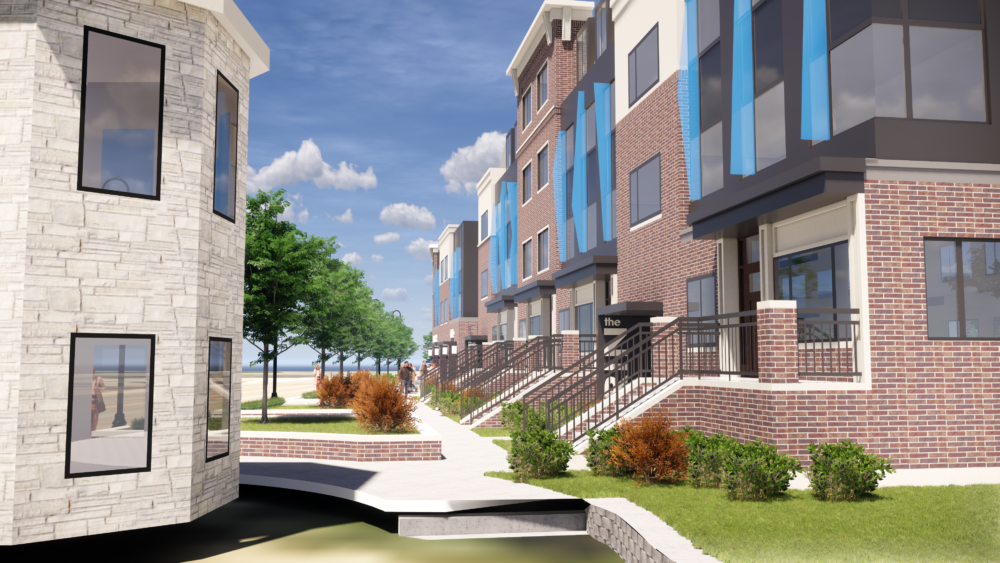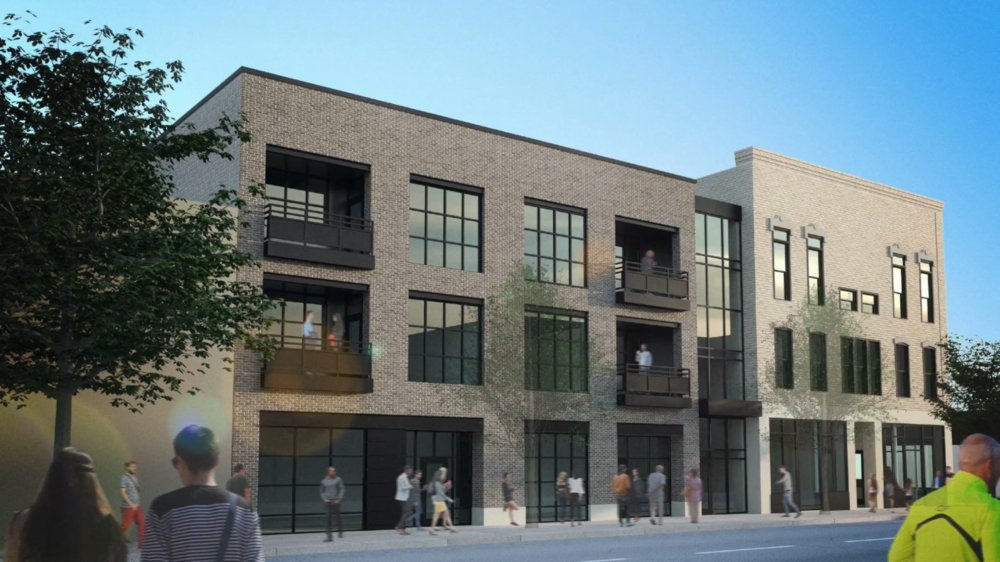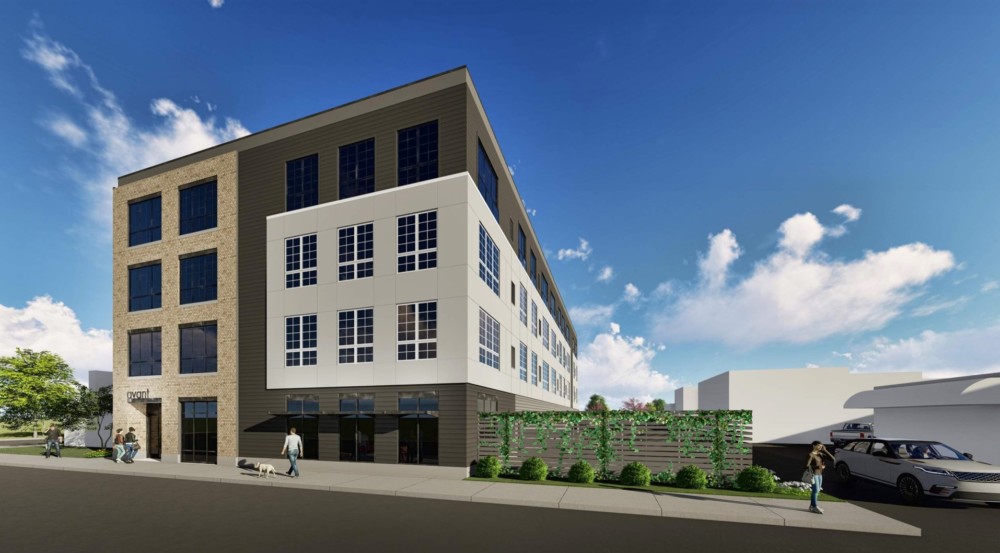Living it Up Downtown
The Fox Cities are experiencing a downtown housing boom
By Amelia Compton Wolff with research assistance by Zack Dion
Appleton resident Abigail Kuehl lives downtown with her husband and three children. Two years ago, the family of five sold their home near Appleton West High School and moved into the Historic Fox River Mills Apartments to be closer to the hustle and bustle of the city’s urban center.
For Kuehl, who owns Bold Salon located in the heart of College Avenue’s business district, the move was a no-brainer.
“Most of what we do is downtown,” she says. “For meetings, I’m downtown. To go out, I’m downtown. We love downtown Appleton. It’s my favorite place.”
Walkability was a key factor in Kuehl’s decision to move. Kuehl enjoys utilizing the scenic Newberry Trail which runs near her apartment while also having retail and dining within arm’s reach.
“I like to walk instead of drive so having the opportunity to walk downtown and have access to coffee shops, bars and restaurants was really important,” she says. “Also, we are busy and didn’t want the [home] maintenance anymore. Not having to shovel or take care of a yard is great.”
More and more Fox Cities residents are finding downtown living to be attractive. With several new housing developments in the works for 2020, there will soon be even more options for those like Kuehl who wish to live and work in the same place.
A Growing Demand
According to the 2016 market analysis done for the City of Appleton’s five-year update to its 2010-2030 Comprehensive Plan, 52 percent of respondents to a public survey indicated they would consider living downtown. This reveals an increase in Fox Cities residents wanting to live in the urban core of the community.
Karen Harkness, City of Appleton’s director of community and economic development, says cultural amenities that improve quality of life are key to attracting people to live in a city’s central business district.
“The Performing Arts Center is just such a jewel that we have here, Lawrence University is another jewel, the Exhibition Center, all of our diverse businesses, the number of restaurants they can choose from, the walkability, access to parks, all of that is so important in creating that invitation to come downtown, to stay downtown, to move downtown,” Harkness says.
As the cultural offerings in the Fox Cities grow, so does the need for additional urban housing in the form of condos and apartments. The City of Appleton’s Comprehensive Plan also reveals that the Fox Cities is in the midst of a significant housing transformation with building permits for single-family units on the decline and authorizations for multifamily units on the rise. Since 2011 in the City of Appleton, the multifamily sector has accounted for an average of 75.4 percent of all construction activity, versus an average of only 24.6 percent for the single family-sector.
Many people believe younger populations are leading this change, but Dan Klister, partner at FORE Development + Investment Group, says millennials and baby boomers alike are influencing it.
“Millennials want to be closer to where they will spend most of their time out of the office and baby boomers are likely ready to downsize from the large suburban home and do the same,” he says.
FORE Development + Investment Group has two residential projects, the Gabriel Lofts and Avant Apartments, under construction in downtown Appleton. Gabriel Lofts, scheduled to open in April, is a renovation of the former Gabriel Furniture building with a new addition to total 21 units. Avant Apartments is a new construction of 33 units north of Heid Music, with an emphasis on efficient layouts and high-end finishes. The project, to be completed in June, includes a common room equipped with a study area, media room and game zone along with an outdoor patio, workout facility and indoor parking for residents.
“We are very excited about the push Appleton, Appleton Downtown Inc. and others have made to emphasize the importance of a vibrant downtown and its correlation to a community’s health and connectedness,” Klister says. “Living options downtown will only help promote growth of business, events and hopefully a lot more to come.”
Downtown Appleton Developments
Currently, the downtown Appleton core (defined as a 1.15 square mile area in Appleton’s Comprehensive Redevelopment Plan with the Fox River bordering on the south, Atlantic Street on the north, South Badger Avenue/South Memorial Drive on the west, and Peabody park bordering the east) has five active residential projects with over 550 units near this central downtown area.
To meet the high demand for more residential units close to downtown Appleton, the approved comprehensive plan has set a goal of establishing 465 new units between 2016 and 2021. In 2019 the City of Appleton invested approximately $4.7 million in support of five housing projects that will get them more than 100 units closer to that goal.
In addition to the Gabriel Lofts and Avant Apartments, these projects include the Tadych Investment Partners’ building with 2,600 square feet of commercial space on its ground floor and 28 apartment spaces on its second floor. It’s located in the former Northshore Bank building at 320 E. College Ave. and set to be completed in 2020. The Block 800 development located at 823, 825 and 827 W. College Ave. will include 20 apartments and 10,000 square feet of new retail space. Finally, Eagle Point Senior Living is adding a 28-unit memory care facility.
In addition, the Crescent Lofts development at 306 W. Washington St. will add 69 new units, 58 of which will be low to moderate income apartments. No investment from the City was involved. The $12 million project on the site of the current Post-Crescent newspaper building will begin construction this fall.
More On the Horizon
Appleton isn’t alone in downtown housing growth. Communities throughout the Fox Cities are experiencing similar increased demands. Chris Haese, director of community development & assessments for the City of Neenah, says the city has two projects in the works that would add roughly 100 units to its downtown. These would be the most significant housing developments in Neenah’s downtown in three decades. Haese hopes to see construction take place on one, if not both, of the projects in 2020.
“Downtowns need retail, office space and housing to be vibrant. Each sector supports the other,” Haese says. “In Neenah we’ve been strong in the office sector and with the amount of retail and public amenities that are in the downtown so it’s become a very obvious location for housing.”
Haese says local employers have helped show the need for additional downtown living options.
“One of the reasons that there’s support for downtown housing is when it comes to talent attraction. There’s a certain segment looking for that kind of housing and that plays a part in if they can accept a position in the area,” he says. “Employers need to provide as many options for prospective employees as they can.”
In downtown Menasha, a $10 million development proposal that would add 46 residential units was recently approved for the former Brin Theatre site. The three-story mixed use building will include a four-story residential building, community gathering spaces and connectivity to the water and trails on the corner of Main St. and Tayco. The project has a tentative completion date of spring 2021.
Amy James is partner at Vision Architecture, the firm behind the building’s design. She says the design of the new development, referred to as The Brin, pays homage to the site’s former 1928 theater that was destroyed by fire in 2018.
“People are drawn to spaces with a story,” James says. “We looked at historical images of the Brin and the aerial view was one of the most notable things. Initial layout and how it curves with the street is somewhat unique. We also carried through some of the brick detail and marquee, but used in a new way with the signage.”
Sam Schroeder, City of Menasha community development director, says the project brings a critical investment on the city’s west development as well as sets a tone for future development.
“Our historic downtown on its eastern portion is very walkable, but as you progress to the west you start to lose that,” Schroeder says. “Our current housing is not conducive to walkability. We are trying to add more connection and make sure that people who live downtown interact with it. They are your greatest asset when they are there.”
Schroeder says the city is currently in talks with developers for mixed-use projects along Menasha’s Water Street corridor, the former Banta printing plant and Whiting Paper Mill site.
“With the locks opening up we can start to tie in these projects over the next five years and really change the dynamic of Menasha in a positive way,” he says. “We are really focusing on creating a place where people want to live and they can be proud of.”
Winter Parade of Homes
February 8-9 & 13-16
Weekends 11 a.m. to 5 p.m. Weekdays 5 to 8 p.m.
Home Builders Association of the Fox Cities (HBA Fox Cities) will be hosting its annual Winter Parade of Homes, an event to tour new-construction and remodeled homes located throughout the Fox Cities, February 8-9 and 13-16. The event features more than 25 houses representing the latest trends and styles. To preview homes and purchase tickets, visit foxcitiesparadeofhomes.com.















Leave a Comment